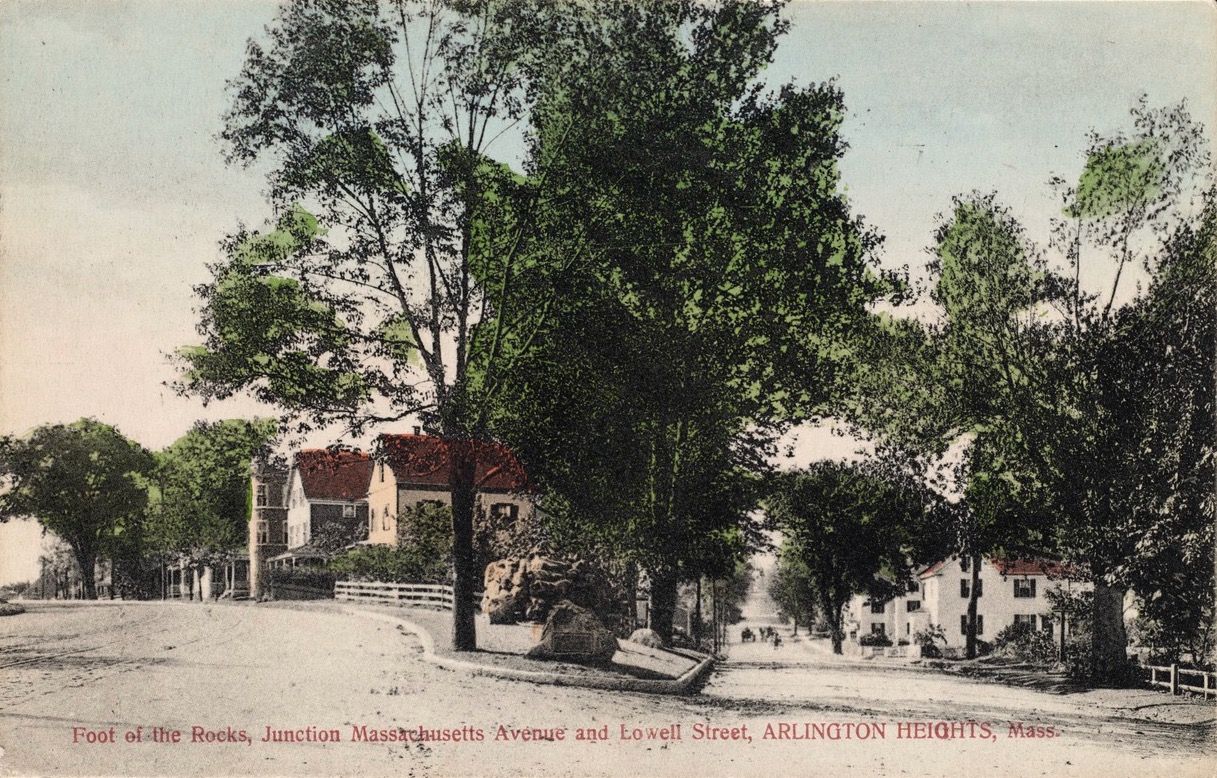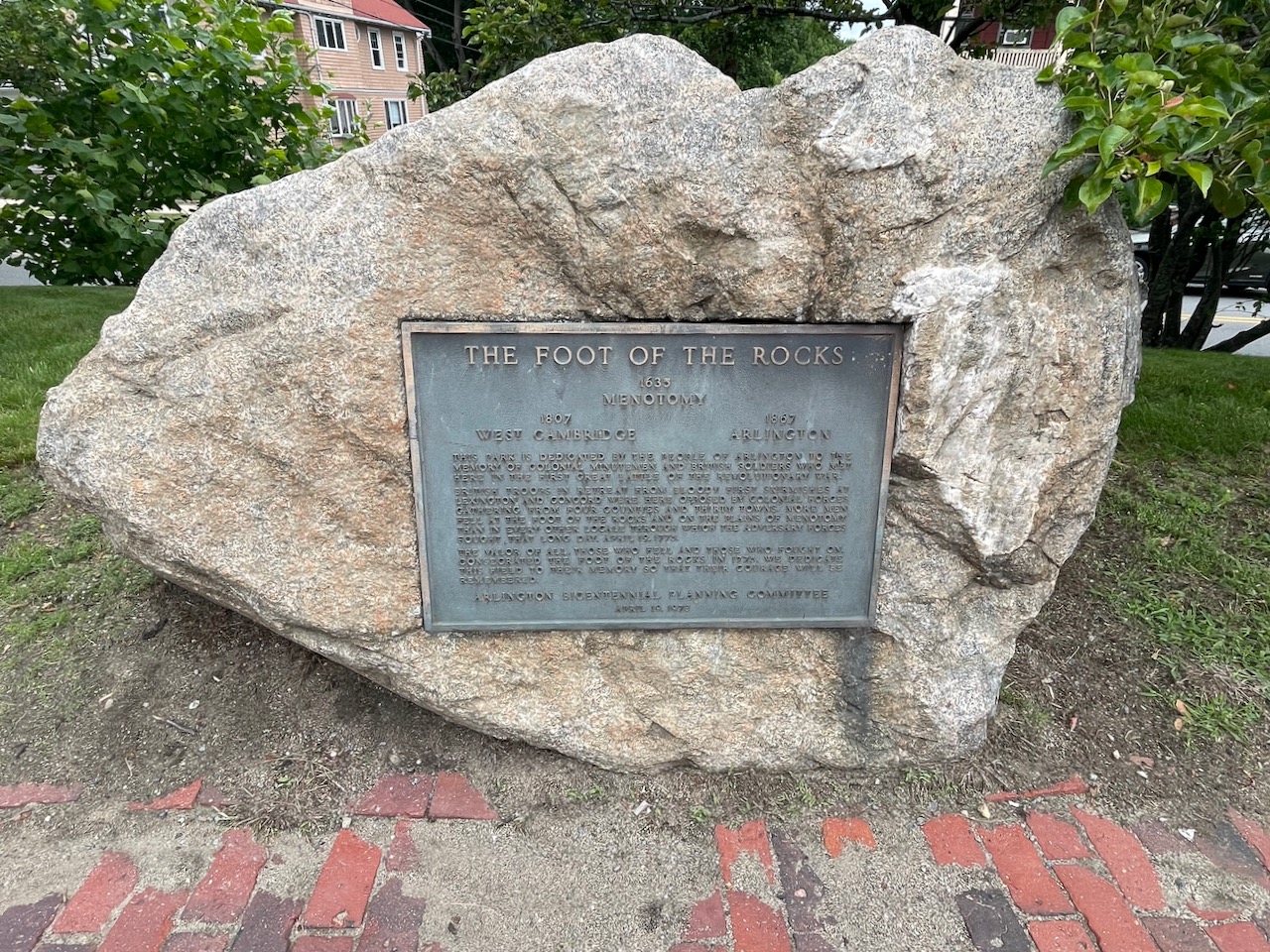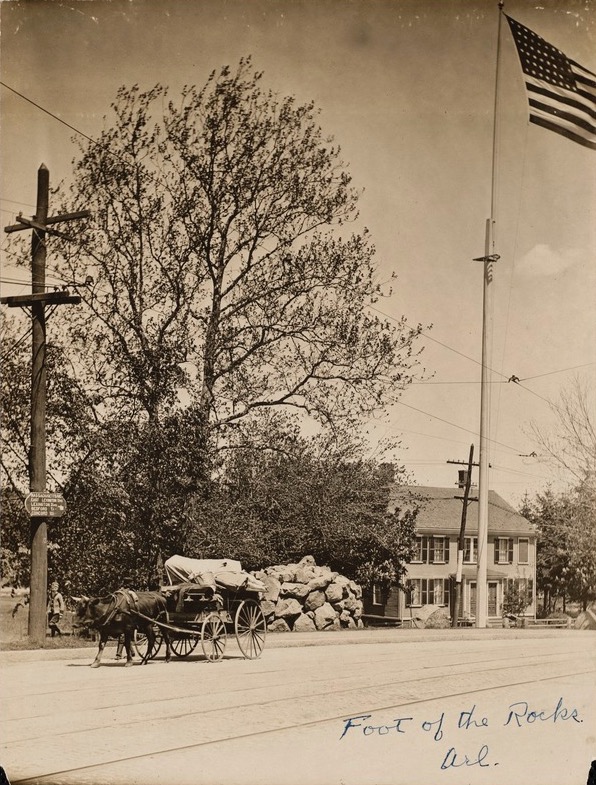
“Foot of the Rocks, junction Massachusetts Avenue and Lowell Street, Arlington Heights, Mass.” Card. Boston, Mass.: Souther-Mears Co., [ca. 1907–1981]. Digital Commonwealth.

THE FOOT OF THE ROCKS
1635
MENOTOMY
1807
WEST CAMBRIDGE
1867
ARLINGTON
THIS PARK IS DEDICATED BY THE PEOPLE OF ARLINGTON TO THE
MEMORY OF THE COLONIAL MINUTEMEN AND BRITISH SOLDIERS WHO MET
HERE IN THE FIRST GREAT BATTLE OF THE REVOLUTIONARY WAR.
BRITISH TROOPS IN RETREAT FROM BLOODY FIRST SKIRMISHES AT
LEXINGTON AND CONCORD WERE HERE OPPOSED BY COLONIAL FORCES
GATHERING FROM COUNTIES AND THIRTY TOWNS. MORE MEN
FELL AT THE FOOT OF THE ROCKS AND ON THE PLAINS OF MENOTOMY
THAN IN EVERY OTHER LOCALE THROUGH WHICH THE ADVERSARY FORCES
FOUGHT THAT LONG DAY, APRIL 19, 1775.
THE VALOR OF ALL THOSE WHO FELL AND THOSE WHO FOUGHT ON,
CONSECRATED THE FOOT OF THE ROCKS IN 1775. WE DEDICATE
THIS FIELD TO THEIR MEMORY SO THAT THEIR COURAGE WILL BE
REMEMBERED.
ARLINGTON BICENTENNIAL PLANNING COMMITTEE
APRIL 19, 1978

“Foot of the Rocks.” Photograph. [ca. 1840–1992]. Digital Commonwealth.
This historical marker, erected by the Arlington Bicentennial Planning Committee in 1978 and sited in a small triangular park at the intersection of Massachusetts Avenue and Lowell Street, commemorates the colonial minute men and British soldiers who met in one of the bloodiest battles on the opening day of the Revolutionary War at the Foot of the Rocks.
Here, British soldiers retreating from Concord and Lexington were ambushed by colonial forces who lay in wait at the highest point along the road from Concord to Charlestown.
The battle at the Foot of the Rocks launched a series of engagements between the British army and the colonial militia that lasted throughout the day until the regulars reached Charlestown around dusk. After the ambush, the British soldiers began attacking civilians and burning buildings, tactics that escalated the violence in and around Boston.
A plaque marking the site of Foot of the Rocks reads:
THE FOOT OF THE ROCKS
1635
MENOTOMY
1807
WEST CAMBRIDGE
1867
ARLINGTON
THIS PARK IS DEDICATED BY THE PEOPLE OF ARLINGTON TO THE
MEMORY OF THE COLONIAL MINUTEMEN AND BRITISH SOLDIERS WHO MET
HERE IN THE FIRST GREAT BATTLE OF THE REVOLUTIONARY WAR.
BRITISH TROOPS IN RETREAT FROM BLOODY FIRST SKIRMISHES AT
LEXINGTON AND CONCORD WERE HERE OPPOSED BY COLONIAL FORCES
GATHERING FROM COUNTIES AND THIRTY TOWNS. MORE MEN
FELL AT THE FOOT OF THE ROCKS AND ON THE PLAINS OF MENOTOMY
THAN IN EVERY OTHER LOCALE THROUGH WHICH THE ADVERSARY FORCES
FOUGHT THAT LONG DAY, APRIL 19, 1775.
THE VALOR OF ALL THOSE WHO FELL AND THOSE WHO FOUGHT ON,
CONSECRATED THE FOOT OF THE ROCKS IN 1775. WE DEDICATE
THIS FIELD TO THEIR MEMORY SO THAT THEIR COURAGE WILL BE
REMEMBERED.
ARLINGTON BICENTENNIAL PLANNING COMMITTEE
APRIL 19, 1978
In October 2022, a master plan by Ray Dunetz Landscape Architecture commissioned by the Town of Arlington was finalized with the goal of providing a new park setting to commemorate the battle site and history of the area. Elements of the master plan include historic interpretation and enhanced accessibility to the site, allowing for this important historic landmark to safely accommodate visitation.

